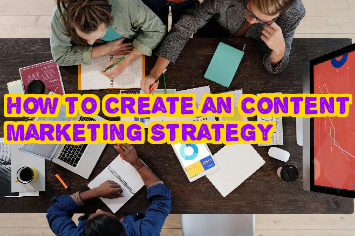
In today’s crowded digital landscape, simply having a website isn’t enough. To truly stand out, attract your ideal customers, and build lasting relationships, you need a powerful tool: content marketing. But it’s not just about writing blog posts or shooting videos; it’s about having a clear, strategic plan.
An effective content marketing strategy isn’t a luxury – it’s a necessity. It ensures every piece of content you create serves a purpose, resonates with your audience, and contributes to your business goals. If you’ve been creating content sporadically, or feeling like your efforts aren’t paying off, it’s time to build a robust strategy.
What Exactly is a Content Marketing Strategy?
At its core, a content marketing strategy is a comprehensive plan for creating, publishing, and distributing content to achieve specific business objectives. It outlines:
- Who you’re trying to reach (your target audience).
- What kind of content you’ll create (blog posts, videos, infographics, etc.).
- Why you’re creating it (your goals).
- How you’ll distribute it (social media, email, SEO).
- When you’ll publish it (your content calendar).
Without a strategy, content creation becomes a guessing game, leading to wasted time and resources.
Why You Can’t Afford to Skip Content Strategy
You might be thinking, “Can’t I just create great content and hope for the best?” While quality is crucial, a strategy amplifies its impact:
- Attracts Your Ideal Customers: By addressing their needs and questions, you naturally draw in people who are genuinely interested in what you offer.
- Builds Authority and Trust: Consistently providing valuable information positions your brand as an expert, fostering trust and credibility.
- Improves Search Engine Rankings: High-quality, relevant content is a cornerstone of SEO (Search Engine Optimization), helping your website rank higher in search results.
- Generates Leads and Sales: Strategic content guides potential customers through the buying journey, from awareness to conversion.
- Increases Brand Awareness and Loyalty: Regular, valuable content keeps your brand top-of-mind and encourages repeat engagement.
5 Key Steps to Crafting Your Content Marketing Strategy
Ready to build a strategy that delivers results? Follow these essential steps:
1. Define Your Audience (Buyer Personas)
This is the absolute first step. You can’t create relevant content if you don’t know who you’re talking to. Develop detailed buyer personas – semi-fictional representations of your ideal customers. Consider:
- Demographics: Age, gender, location, income.
- Psychographics: Interests, values, attitudes, lifestyle.
- Pain Points: What problems do they face that your product or service can solve?
- Goals: What are they trying to achieve?
- Where they consume content: Which social media platforms, blogs, or forums do they frequent?
Knowing your audience inside out will guide every content decision you make.
2. Set Clear Goals (SMART Objectives)
What do you want your content to achieve? Be specific, measurable, achievable, relevant, and time-bound (SMART). Examples:
- Increase website traffic by 20% in six months.
- Generate 50 new leads per month through content downloads.
- Improve brand engagement on social media by 15% in three months.
- Convert 5% more blog readers into email subscribers.
Your goals will dictate the type of content you create and how you measure success.
3. Conduct Content Audits and Keyword Research
- Content Audit: If you already have content, review it. What’s performing well? What needs updating or removing? Identify gaps and opportunities.
- Keyword Research: This is vital for SEO. Use tools to find out what terms your audience is searching for, their search volume, and the competition. Focus on keywords that are relevant to your business and target audience. This will help you brainstorm article titles and topics that people are actively looking for.
- Competitor Analysis: See what content your competitors are producing and what’s working for them. Don’t copy, but learn from their successes and failures.
4. Choose Your Content Types and Channels
Based on your audience, goals, and research, decide what format your content will take and where it will live:
- Content Types: Blog posts, articles, how-to guides, videos, podcasts, infographics, case studies, whitepapers, e-books, webinars, social media posts, email newsletters.
- Channels: Your website (blog), social media platforms (Facebook, Instagram, LinkedIn, YouTube, TikTok, X), email, third-party publications.
A diverse content mix often works best to reach different segments of your audience.
5. Create a Content Calendar and Distribution Plan
Consistency is key. A content calendar helps you plan, organize, and schedule your content creation and publishing. Include:
- Article titles/topics
- Target keywords
- Content type
- Publish date
- Responsible person
- Distribution channels
Your distribution plan outlines how you’ll promote your content once it’s live. Don’t just hit publish and hope! Share on social media, send via email newsletters, consider paid promotion, and actively seek backlinks.
Measuring Success and Adapting
Once your strategy is in motion, don’t just set it and forget it. Regularly monitor key metrics:
- Website traffic: Page views, unique visitors, time on page.
- Engagement: Comments, shares, likes, social media reach.
- Conversions: Leads generated, sales, sign-ups.
- SEO performance: Keyword rankings, organic traffic.
Analyze what’s working and what isn’t. Be prepared to adapt your strategy based on data and changing market trends. Content marketing is an iterative process – continuous improvement is the path to long-term success.
By following these steps, you’ll move beyond just creating content and start building an effective content marketing strategy that drives real, measurable results for your business.
